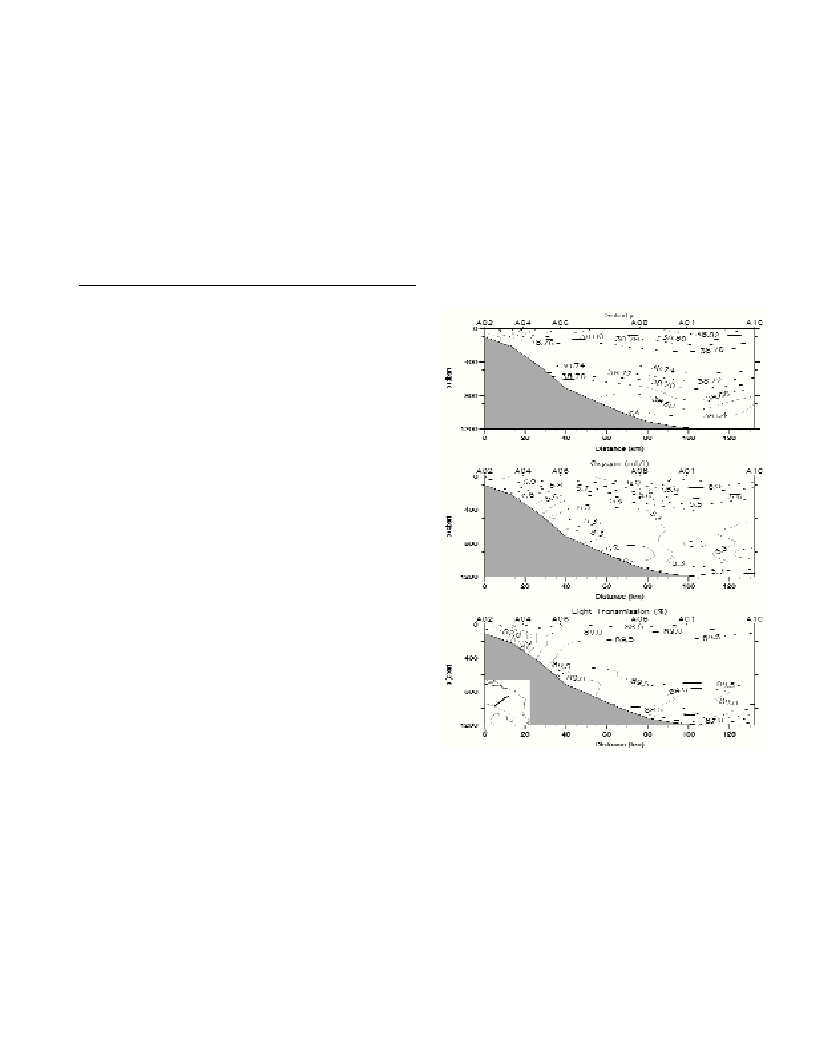Rapp. Comm. int. Mer Médit., 37,2004
122
DENSE WATER FORMATION IN THE SOUTHERN ADRIATIC SEA ASSOCIATED WITH VARIATIONS OF
THE THERMOHALINE CIRCULATION IN THE IONIAN SEA DURING 2001-2002
Beniamino B. Manca
1*
, Giuseppe Civitarese
2
, Birgit Klein
3
, and Maurizio Ribera d’Alcalà
4
1
Istituto Nazionale di Oceanografia e di Geofisica Sperimentale - OGS, Borgo Grotta Gigante 42/c, 34010 Sgonico (Trieste), Italy
* bmanca@ogs.trieste.it
2
Istituto Scienze del Mare, Sezione di Trieste, Trieste, Italy, g.civitarese@ts.ismar.cnr.it
3
University of Bremen, Institute of Environmental Physics, Bremen, Germany, bklein@physik.uni-bremen.de
4
Stazione Zoologica ‘A. Dohrn’, Napoli, Italy, maurizio@alpha.szn.it
Abstract
Hydrographic observations conducted in the southern Adriatic and Ionian Seas during 2001-2002 asses the role of the Adriatic in driving
the deep/internal thermohaline circulation of the Eastern Mediterranean. The concurrent presence of key elements in the southern cyclonic
gyre (i.e. strong atmospheric forcing and the exposure of highly saline waters at surface) and the arrival of dense waters from the northern
shelf caused the deep ventilation of the bottom layer. The mixing between the pre-existent ‘older’deep waters and the new discharged one
has been estimated, along with the salt contents and some biochemical elements budgets, following the transient event.
Keywords: Adriatic Sea, deep convection, thermohaline circulation
Introduction
The factors controlling the dense water formation in the Adriatic
Sea have been largely studied using field observations and modelling
simulations [1]. Dense water formation events occur in the southern
Adriatic Sea by open-ocean deep convection because of winter
outbreaks of northerly cold air masses and of highly saline waters
from the Eastern Mediterranean that regularly intrude into the Adriatic
Sea at the intermediate layer. Dynamic topography maps based on
individual hydrographic cruises have shown consistently a
topographically controlled baroclinic cyclonic circulation and
periodical exposures at surface of highly saline waters [1], often
associated with vigorous air-sea interactions during the winter.
However, the deep ventilation of the bottom layer has not been
observed during the last two decades. The overall objective of this
work is to assess the regained role of the Adriatic Sea as site of dense
water formation for the Eastern Mediterranean, which was
temporarily reduced during the ascendant and the mature phase of the
Eastern Mediterranean Transient (EMT).
Results and Discussion
The data used for this study were collected during late winter in
March-April 2002 in the Adriatic-Ionian region within the SINAPSI
(Seasonal, INterannual and decAdal variability of the atmosPhere,
oceanS and related marIne ecosystems) national programme. The
field investigations have indicated a prevailing increase of the salinity
in the Southern Adriatic Sea according to the spreading of the highly
saline Cretan Intermediate Water [2], which intruded into the Adriatic
Sea. In the Southern Adriatic gyre, the deep ventilation of the bottom
layer (1200 m) have been observed along with a density-driven
bottom current transporting less saline, cold and highly ventilated
dense water into the deep Ionian basin.
Figure 1 shows the vertical water-mass structure in the Southern
Adriatic gyre, exemplified by the salinity, oxygen and beam
attenuation coefficients measured by means of transmissometer.
These observations indicate: (i) the presence of highly saline water
masses at surface (S>38.80), consistent with changes in the Eastern
Mediterranean circulation; (ii) the deep convection in the centre of the
cyclonic gyre exemplified by the deep ventilation down to 800-1000
m (O
2
> 5.35 ml/l); and (iii) the presence of a highly ventilated water
mass (O
2
> 5.40 ml/l) in the bottom layer, presumably cascading from
the shelf/slope. This interpretation is further confirmed by an increase
of suspended material in the bottom layer because of the re-
suspension of the sediment as the water mass is cascading along the
shelf/slope.
In synthesis, in 2002 the dense waters that reside in the deep
southern Adriatic reservoir were renewed. However, the deep
convection did not reach the bottom layer, allowing us to conclude
that the signal of the ventilation of the bottom waters is associated
with a large contribution from the northern shelf region. As
concluding remark we can say that it took almost one decade from the
maximum manifestation of the EMT for the Adriatic Sea to resume
the leading role for the dense waters production of the Eastern
Mediterranean.
Fig. 1. Vertical distribution of Salinity, Dissolved Oxygen (ml/l) and Light
Transmission (%) along the section in the southern Adriatic Sea (see
inset map) in early April, 2002.
References
1-Gacic M., Lascaratos A., Manca B.B., and Mantziafou A.,
2001.Adriatic deep water and interaction with the Eastern Mediterranean
Sea. Pp. 111-142. In: Physical Oceanography of the Adriatic Sea, B.
Cushman-Roisin et al.(eds.), Kluwer Academic Publishers.
2-Manca B.B., Budillon G., Scarazzato P., Ursella L., 2003. Evolution of
dynamics in the eastern Mediterranean affecting water masses structures
and properties in the Ionian and Adriatic Seas. J. Geophys. Res.,108(C9),
8102, doi:10.1029/2002JC001664.

